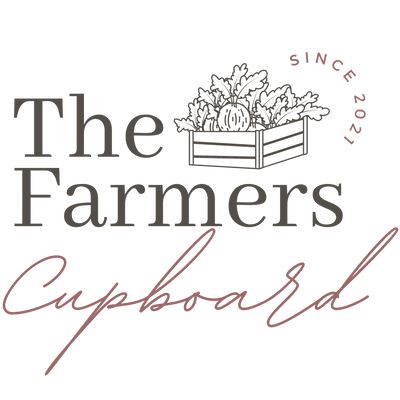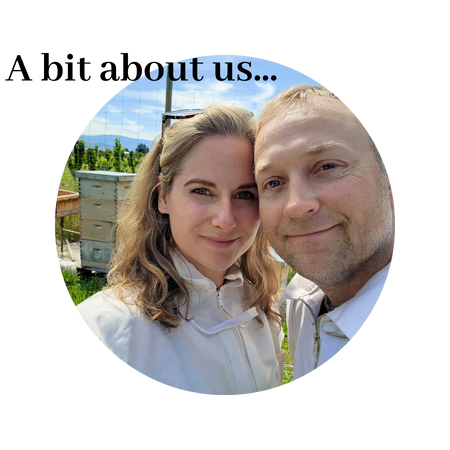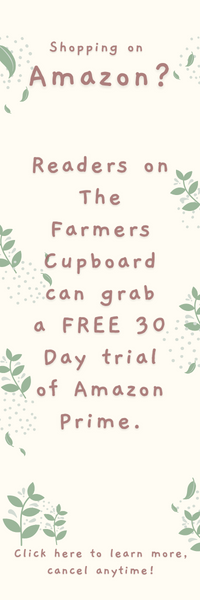Beeswax wraps are a type of food storage wrap that is made from a mixture of beeswax, tree resin, and fabric. They are used as an alternative to plastic wrap or aluminum foil for wrapping and storing food.
We personally love using beeswax wraps for our food as they are reusable, handmade, and we can get rid of all that excess single plastic use. We don't want that on our food anyways.
Beeswax wraps can be used as an all natural, eco friendly alternative in the following ways:
- to store baked goods
- to cover bowls
- as food wraps (for picnics or for take away lunches)
- to store fruits and vegetables
- and they can be used with the dumpling style fold to be made into tiny containers for snacks

Beeswax wraps are reusable and can be molded around food items to keep them fresh. They are also biodegradable and compostable, making them a more environmentally friendly option than traditional plastic wraps!
To use a beeswax wrap, you simply wrap it around the food item you want to store, and the beeswax will help to seal the wrap and keep the food fresh.
The tree resin (such as pine resin) in the wrap will allow it to stick to your container or to itself as the seal, and they can be washed and reused over and over again.
Have you thought of replacing your plastic wrap or foil with natural beeswax wraps? You are not alone.
Natural food wraps have made a huge splash in the DIY world and for good reason too. They are easy to make, or, you can easily purchase them from a handmade seller.
And don't worry, once you decide if beeswax food wraps are for you, we have resources for both of those options (making or purchasing wraps) below.
Shop for handmade beeswax wraps right here
Shop for real beeswax directly from beekeepers here
Let's get into it!
Pros and Cons of Beeswax Wraps
Beeswax Wrap PROS
There are several pros to using beeswax wraps as a food storage option:
1. Reusable: Beeswax wraps can be used over and over again, which helps to reduce waste.
2. Environmentally friendly: Beeswax wraps are biodegradable and compostable, making them a more sustainable option than traditional plastic wrap.
3. Safe for food storage: Beeswax is a natural and safe material for food storage, and it has antimicrobial properties that can help to keep food fresh.
4. Versatile: Beeswax wraps can be used to store a variety of foods, including vegetables, fruits, cheese, bread, and sandwiches.
5. Easy to use: Beeswax wraps are easy to use – simply wrap them around the food item you want to store and the beeswax will help to seal the wrap and keep the food fresh.
6. Customizable: Beeswax wraps can be made in a variety of sizes and shapes, making them easy to customize to your specific needs, and if you are making them yourself, you can choose the material pattern as well. How great is that? (There are some really cute patterns out there!)
7. Aesthetically pleasing: Many people find beeswax wraps to be attractive and stylish, making them a nice addition to their kitchen. They also sell great at craft fairs if you start making them and have that entrepreneurial spirit!
8. Supporting small farmers: When you decide to make your own beeswax wraps, you will want to buy pure beeswax that has not been mixed with other oils for volume. The best way to do this? Buy direct from your beekeepers. Don't worry, we have a list of resources for you to buy direct from beekeepers online, and you can be sure the beeswax you buy is pure and is ethically harvested.
9. Giftable: Beeswax wraps also make amazing handmade gifts, so it is easy to spread the love.
Honestly, we could go on with beeswax wraps pros, but this list really sums them up nicely.
In summary, they are efficient, environmentally friendly, it is a food grade wax with natural ingredients, they clean easily, gift beautifully and are compostable.
There are so many ways to use natural beeswax, read the BEST uses for natural beeswax right here.
But let's talk about the cons of beeswax wraps to give you a full rounded idea for your purchasing and DIY decisions.
Beeswax Wraps CONS
There are a few potential cons to using beeswax wraps as a food storage option:
1. Limited lifespan: Beeswax wraps have a limited lifespan and will eventually need to be replaced. They typically last for several months to a year, depending on how frequently they are used and how well they are cared for.
*We still think they are better than single use plastic bags, plastic wraps and plastic waste in general - just something to consider for this point.
2. Cost: Beeswax wraps can be more expensive than traditional plastic wrap or aluminum foil, whether you are making them or purchasing them. The cost incurred includes the beeswax, the cotton, and the other small key ingredients.
3. Care and maintenance: Beeswax wraps require some care and maintenance to keep them in good condition. They should be washed with cold water and mild soap, and should not be used to wrap hot or wet foods.
4. Limited temperature tolerance: Beeswax wraps should not be used in the microwave or for storing food in the freezer. They are best for storing food at room temperature or in the fridge and should not be washed with hot water.
5. Not suitable for all types of food: Beeswax wraps may not be suitable for storing all types of food. For example, they may not be the best option for storing very wet or greasy foods or raw meat, as the beeswax may not be able to effectively seal the wrap and prevent spills or leakage.
So there are definitely some pros and cons of beeswax wraps.
After reading through these points, what are you thinking? Are you going to stick with the ways of plastic containers and plastic cling wrap or switch over to a beeswax wrap?
Our suggestion for Beeswax Wraps:
If you are thinking of making the switch from plastic to a beeswax wrap: Try them out.
See the BEST Beeswax Wraps Here (article)
You don't have to completely switch over to only wax wraps and get rid of all of your plastic wrap and other food wraps you already have on hand.
Remember, there are many things you can use beeswax wraps for and some food items aren't great for these wraps, so why don't you start by including these natural wraps in your storage options and integrate them into your everyday use? See how you like them?
If you have never used these wraps before, we would suggest buying some to see how you like them.
Check the price of beeswax wraps by handmade sellers here
Once you have used beeswax food wraps and find that they are great for you, you can purchase more, or try making them yourself!
We have a really great tutorial on making homemade beeswax wraps with a list of the ingredients which we will leave below, so go ahead and bookmark this page (or that one) so you can come back to the resource.
Here it is:
Beeswax Wrap Tutorial
We also have a resource for you to purchase pure beeswax directly from the beekeepers (unless of course you have your own bees or want to learn the basics of beekeeping and how to get started beekeeping), there are about ten or so that we have listed that are farm-to-table models.
You can trust these small businesses to not put any other waxes in with their beeswax. Here is that resource for you as well:
Where To Buy Beeswax Directly From The Beekeepers
There will be some other key ingredients in making your own beeswax wraps such as organic cotton cloth, organic jojoba oil or coconut oil, pine resin or a tree resin and a good gentle soap to wash your beeswax wraps with.
We will link below to a soap that is gentle enough to wash and preserve your wraps with.
This is the soap that we recommend using with your beeswax wraps (you can read why this soap is the best in our article where we use it to make DIY insecticidal soap, it's quite interesting to learn about the ingredients in soap!)
Just remember to simply wash your beeswax wraps in cool water (not hot water) and let them completely dry before using again to maintain that wax and stickiness.
Well, we hope we helped you make a great decision, whether you want to stick with your plastic wrap and plastic containers, or switch over to compostable beeswax wraps.
Here are some other articles you may be interested in reading:
Where To Buy Real Beeswax (ARTICLE)
Beekeepers Who Sell Pure Beeswax (SOURCE)
How To Make Beeswax Lip Balm (RECIPE)
The BEST Ways To Use Natural Beeswax In Your Home
Beekeeping Equipment List | How To Start
Learn How To Make Beeswax Furniture Polish
Did you like this article?
❤️ Here's how you can support our blog:
My name is Linnea and I am a backyard gardening enthusiast! Along with my husband and our two kids (and chickens, ducks, bees and our little dog). Our hobby - growing our own food and making our meals from scratch. My blog, The Farmers Cupboard, is the website that blossomed from that passion. I love every second I spend sharing our hobby with like minded backyard growers.
It's easy to support my blog, and it is so appreciated. Please SHARE an article somewhere, pin a photo to your Pinterest board, follow on any of our social medias or sign up for our newsletter! That's it!
These little things help our blog grow and allow us to continue doing what we love: growing good food and sharing what we learn.
PINTEREST PASSIONATE? We're opening up our cupboard to you!
Click on the pin below made just for you. It will bring you right to my little Pinterest community, where I would love for you to FOLLOW The Farmers Cupboard and see all of our gardening and backyard dream ideas!
Let's grow good things together!













0 comments